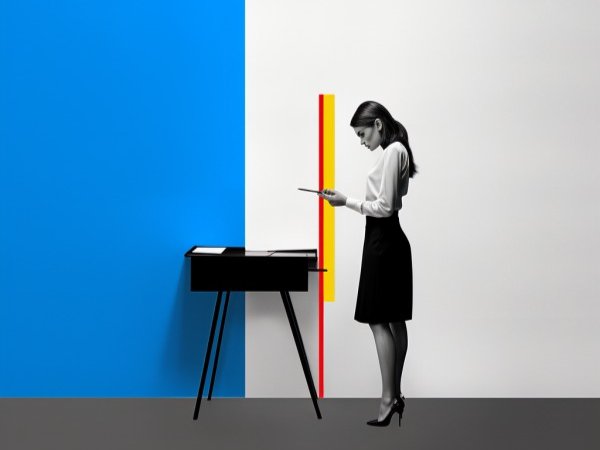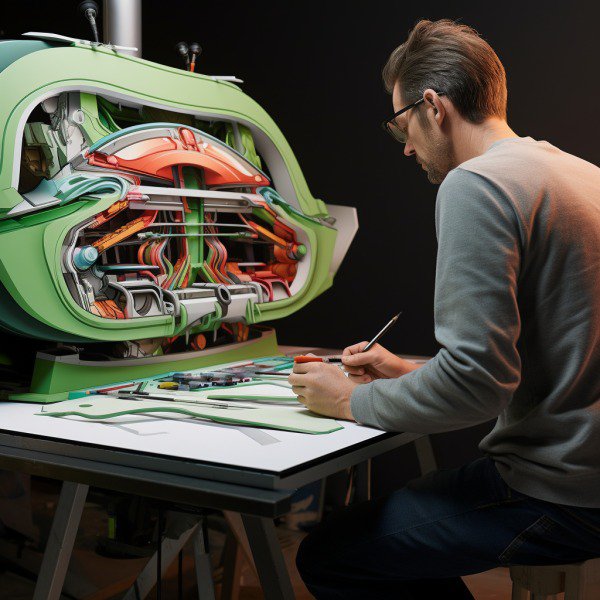Have you ever been amazed by the smooth experience of using your preferred app or web page? Ever wonder who’s behind it all? Enter the world of Digital Product Design Career Opportunities. These are the folks blending art and tech, crafting experiences that solve real problems for real people.
The digital landscape is constantly evolving, like a canvas where new ideas come to life. It’s not just about making things look good – it’s also about understanding what users need even before they do.
Whether you’re an aspiring product designer, a business owner eager to understand the impact of design on their bottom line, or a high-level professional with an IQ of 150 looking to break into this field, we’ve got you covered. From deciphering job descriptions to demystifying UX/UI roles, we’ve got you covered. Stick around as we pull back the curtain on this exciting career path…
Table of Contents:
- The Intersection of Tech and Creative Design: Product Design
- Role and Responsibilities of a Product Designer
- The Value Addition by Good Product Managers
- UX/UI Designers vs. Product Designers
- Skills Required for a Career in Digital Product Design
- FAQs in Relation to Digital Product Design Career Opportunities
- Conclusion
The Intersection of Tech and Creative Design: Product Design
Imagine the digital world as a vast ocean, where tech is the water that fills it and creative design is like an elegant sailboat gliding across. That’s what product design in the tech industry feels like – an exhilarating journey filled with creativity, innovation, and problem-solving.

The Emergence of Digital Product Design
In its early stages, digital product design was merely seen as a subset of graphic design or software development. But over time, just like a butterfly emerging from its cocoon, it has evolved into its own discipline.
Digital products have become ubiquitous, permeating our lives through a variety of mediums beyond just websites and apps. From wearable technology to smart home devices – if you’re interacting with it digitally somehow, there’s a digital product designer behind it.
Around 1 out of every 10 companies are now investing heavily in hiring skilled digital designers due to their ability to transform user experiences through thoughtful designs (source). And this number will only rise further as businesses increasingly understand how crucial good designs are for driving customer satisfaction (statistic 2).
The Art and Science Behind Product Design
Successful products don’t happen by accident—they’re born out of rigorous processes that combine artistry with scientific precision.
An outstanding example would be Apple’s iPhone—behind its sleek appearance lies meticulous engineering combined seamlessly with aesthetically pleasing graphics. The perfect blend of aesthetics and performance is the aim of product design.
And that’s not all. There’s a whole world beyond just aesthetics in product design. It includes understanding users, their behaviors and needs, empathizing with them, prototyping ideas quickly, and testing these prototypes on real people to solve real problems.
Role and Responsibilities of a Product Designer
A digital product designer’s job description goes beyond simply designing products; they play an integral role in shaping user experiences too. They wear many hats – from being an art director who defines the visual style to playing the role of UX/UI designer ensuring intuitive navigation.
Key Thought:
Think of digital product design as a dance between tech and creativity, transforming our interaction with everyday devices. It’s more than aesthetics; it’s about understanding user needs, testing prototypes and delivering seamless experiences. Product designers aren’t just artists but also UX/UI experts shaping intuitive navigation.
Role and Responsibilities of a Product Designer
A product designer’s role extends beyond sketching eye-catching designs. Their work is a unique blend of user experience (UX design), project management, and even aspects of product management.
The Advocacy Aspect of Product Design
A successful digital product designer does more than create appealing visuals; they act as the advocate for the end-user. They immerse themselves in understanding what users need, desire, or struggle with when interacting with similar products on the market.
This deep comprehension helps them to identify potential roadblocks early in the design process and propose user-centric solutions. For example, let’s say our talented designer works at an e-commerce website like Amazon; their job would involve understanding how real people navigate through thousands of products to find what they want quickly and efficiently.
In fact, according to Statista, key stat 4 suggests that user-friendly websites lead to higher customer retention rates. So designers who put their users first are directly contributing to company success.
Collaboration in Product Design
Nobody operates alone within a company – especially not product designers. These creatives frequently collaborate with various departments such as software development teams, marketing squads or other stakeholders involved in shaping up final consumer products.
You might wonder why? It’s simple: each department brings its own set of insights which can enrich overall design decisions significantly. Imagine if you were designing an app for fitness enthusiasts without ever having spoken to someone from your team who happens be one. The result could be far off track from actual user needs.
“Product designers must see collaboration not just as part of their job description, but as a way to amplify the success of their designs,” says Jacob Cass, renowned designer and founder of Just Creative.
But teamwork isn’t everything. Designers also gotta have top-notch chat skills for client meetings, whether they’re showing off design prototypes or taking on feedback. Adobe’s 2023 Digital Trends report even points out that key stat 5 backs this up.
Key Thought:
A product designer’s role is more than just crafting visuals. They’re the end-user’s advocate, understanding user needs and solving problems. Collaboration with different departments enriches design decisions and contributes to company success. Good communication skills are vital for effective client meetings.
The Value Addition by Good Product Managers
Good product managers bring a lot more to the table than what’s in their job description. They create real value, driving the success of both products and companies.
Strategic Decision-Making in Product Management
A crucial part of being a good product manager is guiding strategic decision-making within an organization. Decision-making should take into account all elements that could affect the company’s objectives.
In this role, they need to consider things like software development processes and market trends while balancing stakeholder interests. By doing so, they can help steer teams towards successful outcomes even when faced with complex challenges or difficult trade-offs.
This approach requires them not only to be great communicators but also effective leaders who can inspire their team members towards shared objectives. It means knowing how to navigate diverse personalities on design teams as well as stakeholders from other departments such as marketing or sales.

Driving User-Centric Design Processes
Beyond strategic decisions, another key responsibility for good product managers is ensuring user needs are met throughout design and development stages.
This task calls upon hard skills such as data science expertise alongside soft ones like empathy – because understanding real people with real problems is vital if you’re going to make consumer products that solve those issues effectively.
Drawing Out Great Ideas From The Team
If you’ve ever wondered why some companies seem always able produce innovative solutions time after time – chances are there’s an exceptional product manager at work behind scenes encouraging creativity among staff members. These individuals know importance bringing out best everyone around them whether artist director responsible creating visually appealing interfaces web developer tasked turning these designs into functional applications.”
Tapping into talents and ideas of team members, good product managers can lead the creation of a final product that’s not only high-quality but also innovative. This requires them to have an in-depth understanding of their team’s capabilities as well as how best to leverage these for project success.
Value Through Project Ownership
The role doesn’t stop at driving design processes or encouraging creativity though; it extends all way into ownership over projects themselves.
Key Thought:
Top-notch product managers add value far beyond their job description. They’re strategic decision-makers, guiding the team with a blend of hard skills and empathy to ensure user needs are met. Their knack for drawing out great ideas turns them into catalysts of innovation, while project ownership seals their commitment to success.
UX/UI Designers vs. Product Designers
In the ever-evolving digital world, the line between UX/UI designers and product designers can seem blurred. But, they have distinct roles and responsibilities that are crucial in shaping a successful product.
The Visual Focus of UX/UI Designers
A UI (User Interface) designer, often confused with a graphic artist or web developer, focuses on creating visually appealing interfaces for software applications or websites. They’re like the architects of visual design in digital spaces – crafting every button press, scroll action, and animation sequence – all while keeping user interaction at heart.
The UI Designer’s job is akin to an art director for web applications: their canvas being your screen. This role demands strong visual communication skills as well as technical knowledge about current trends in interface design. Key Stat 8: According to Adobe’s annual report on Digital Trends 2023; nearly half (49%) of businesses worldwide consider ‘design’ as extremely important for enhancing user experience.
A UX (User Experience) designer dives deeper into understanding users’ needs and expectations from products or services by focusing more on how it feels rather than looks alone. Imagine them acting like therapists who decipher what users truly want through research methods such as surveys, interviews & usability testing, etc., before sketching out wireframes based on these insights gained. Key Stat 9: A recent study found that every $1 invested in improving UX results in a return between $2-$100 dollars.
The Holistic Approach of Product Designers
Moving onto our other contender, the product designer. A product designer takes a holistic approach to design, combining UX/UI design skills with project management and even some aspects of marketing.
Product designers don’t just focus on how users engage with apps or websites. They think about everything, from the spark of an idea to the final roll-out. It’s like they’re playing both architect and builder for digital goods. Their job is crafting top-notch prototypes that are more than just pretty—they work seamlessly too. Always pushing forward, their goal is to create products that solve genuine issues. Key Stat 8: Research indicates getting Product Design involved early in development can
Key Thought:
UX/UI designers and product designers both play crucial roles in shaping successful digital products. UX/UI designers focus on visual appeal, crafting engaging interfaces with user interaction at heart. Product designers take a broader approach, combining design skills with project management to create prototypes that not only look good but solve genuine issues.

Skills Required for a Career in Digital Product Design
If you’re considering a career as a digital product designer, there’s an array of skills that you’ll need to master. These include both hard skills like software development and web applications design, as well as soft ones such as communication and teamwork.
The Hard Skills Every Digital Product Designer Needs
As the world continues its rapid shift towards digitization, the demand for proficient digital product designers has skyrocketed. A few core technical abilities have emerged at the forefront:
- Digital Marketing & Social Media Savviness: As most consumer products now live online or are digitally marketed on platforms like Instagram or Facebook, understanding how these systems work is essential.
- Data Science Knowledge: Being able to analyze user data can provide valuable insights into designing more effective products.
- E-Commerce Website Development Skills: The boom in e-commerce means designers should know their way around building high-functioning shopping sites. This also involves some level of UX/UI design proficiency – making sure your final product not only looks good but works seamlessly too.
Nurturing Your Soft Skills: Communication and Collaboration
A successful digital product designer doesn’t just excel technically—they also possess excellent interpersonal abilities. For instance, clear communication with real people—be it clients or team members—is vital when creating solutions to solve real problems.
- Social media prowess: In this role, you often need to collaborate closely with social media teams, to ensure cohesive branding across different platforms. Social Media Today offers great resources on how to leverage social media for digital product design.
- Working in Agile project environments: This requires excellent communication skills, as designers need to be able to understand and respond quickly to changes in the project’s scope or direction.
Finding Your Niche: UI/UX Design, Web Developer or Art Director?
Right in the thick of it,
Key Thought:
To succeed in digital product design, you’ll need a mix of hard and soft skills. You’ve got to master technical abilities like data analysis, e-commerce development, and digital marketing while also nailing down communication and teamwork. Remember that understanding social media platforms is key as most products live online or are digitally marketed there.
FAQs in Relation to Digital Product Design Career Opportunities
Is digital product design a good career?
Digital product design is indeed a solid career. It’s growing rapidly, pays well, and offers creative satisfaction.
What does a digital product designer do?
A digital product designer crafts the look and feel of software products. They balance aesthetics with functionality to create user-friendly experiences.
Is digital design in high demand?
Absolutely. With businesses increasingly going online, the need for skilled digital designers has skyrocketed.
What is a career in product design?
A career in product design involves designing physical or virtual goods that solve specific customer problems effectively and attractively.
Conclusion
Digital Product Design Career Opportunities are booming, and the right skills can put you at the forefront. From understanding user needs to crafting engaging interfaces, product design is an exciting blend of art and tech.
A designer’s job isn’t just about making things aesthetically pleasing; they must identify and address actual issues for their users by creating user-friendly digital solutions. They solve real problems for real people by creating intuitive digital experiences.
And it’s not all about individual talent – collaboration with stakeholders across various departments ensures successful outcomes. In fact, advocacy on behalf of users is key in this role.
The road to success in product design requires patience and strategic planning but with these insights under your belt, you’re well on your way!




![What is UX design? [Fully updated guide for 2024] 10 What is UX design? [Fully updated guide for 2022] cover](https://www.designmatch.io/wp-content/uploads/2022/11/unsplash-image_0b1fd52bdfb19510a2b539f150476d11_2000-1024x682.jpg)